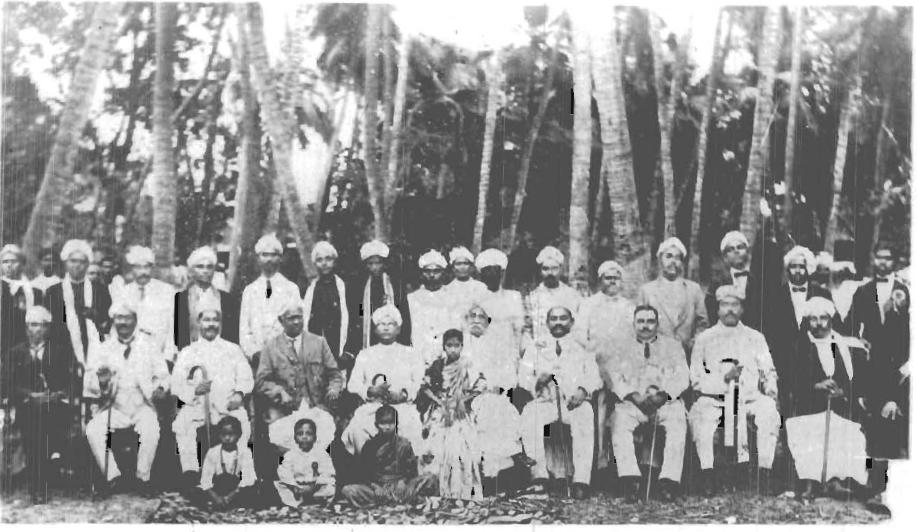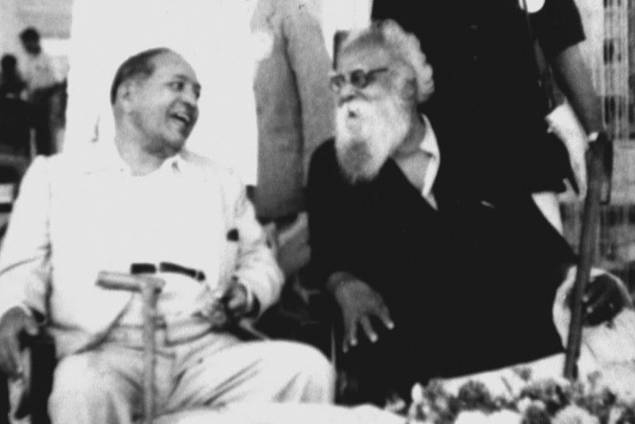|
South Indian Liberal Federation
The Justice Party, officially the South Indian Liberal Federation, was a political party in the Madras Presidency of British India. It was established on 20 November 1916 in Victoria Public Hall in Madras by Dr C. Natesa Mudaliar and co-founded by T. M. Nair, P. Theagaraya Chetty and Alamelu Mangai Thayarammal as a result of a series of non-Brahmin conferences and meetings in the presidency. Communal division between Brahmins and non-Brahmins began in the presidency during the late-19th and early-20th century, mainly due to caste prejudices and disproportionate Brahminical representation in government jobs. The Justice Party's foundation marked the culmination of several efforts to establish an organisation to represent the non-Brahmins in Madras and is seen as the start of the Dravidian Movement. During its early years, the party was involved in petitioning the imperial administrative bodies and British colonial officials demanding more representation for non-Brahmins in ... [...More Info...] [...Related Items...] OR: [Wikipedia] [Google] [Baidu] |
Theagaroya Chetty
Sir Pitti Theagaraya Chetty KCSI (27 April 1852 – 28 April 1925) was an Indian lawyer, industrialist and a prominent political leader from the erstwhile Madras province. He was one of the founders of the Justice Party in 1916 along with C. Natesa Mudaliar, Dr. T. M. Nair. T.Nagar is a locality in Chennai which is named after him. On 1919 January 1, the title Dewan Bahadur was awarded to him Theagaraya Chetty was born in Madras Presidency. After graduating from Presidency College, Madras he served as a corporator and legislator. He had an avid interest in politics and served as a member of the Indian National Congress before founding the South Indian Liberal Federation in 1917. He served as the president of the federation from 1917 till his death in 1925. Early life Chetty was born to a Devanga family in Egathur, Madras Presidency on 27 April 1852. He did his schooling in Chennai and graduated in law from Presidency College, Madras. On graduation, he entered public life ... [...More Info...] [...Related Items...] OR: [Wikipedia] [Google] [Baidu] |
Montagu–Chelmsford Reforms
The Montagu–Chelmsford Reforms or more briefly known as the Mont–Ford Reforms, were introduced by the colonial government to introduce self-governing institutions gradually in British India. The reforms take their name from Edwin Montagu, the Secretary of State for India from 1917 to 1922, and Lord Chelmsford, the Viceroy of India between 1916 and 1921. The reforms were outlined in the Montagu-Chelmsford Report, prepared in 1918, and formed the basis of the Government of India Act 1919. These are related to constitutional reforms. Indian nationalists considered that the reforms did not go far enough, while British conservatives were critical of them. The important features of this act were that: 1. The Imperial Legislative Council was now to consist of two houses: the Central Legislative Assembly and the Council of State. 2. The provinces were to follow the ''Dual Government System'' or ''dyarchy''. Background Edwin Montagu became Secretary of State for India in June 1917 ... [...More Info...] [...Related Items...] OR: [Wikipedia] [Google] [Baidu] |
Annamalai University
, logo = CampusmapofAU.jpg , image = Annamalai University logo.png , image_size = 225px , motto = "With Courage and Faith" , established = , type = State University (Government) , endowment = , administrative_staff = , faculty = , president = , principal = , rector = , chancellor = Governor of Tamil Nadu , vice_chancellor = R. M. Kathiresan , head_label = , head = , academic_staff = 2,281 , students = 32,480 , undergrad = 23,256 , postgrad = 8,067 , doctoral = 998 , city = Chidambaram, Tamil Nadu , country = India , coordinates = , campus = Rural, , campus_size = , languag ... [...More Info...] [...Related Items...] OR: [Wikipedia] [Google] [Baidu] |
Andhra University
Andhra University (IAST: ''Āndhra Vișvakalāpariṣhat'') is a public university located in Visakhapatnam, Andhra Pradesh, India. It was established in 1926. History King Vikram Deo Verma, the Maharaja of Jeypore was one of the biggest donors of the university. He donated lands and two million rupees for the establishment of the university which was set to be shifted elsewhere by the education authorities due to lack of funding. Furthermore, he provided lakh annually to the university, an approximate figure of lakhs between 1930s - 1940s.a The liberal king was conferred an Honorary Doctorate degree from the university. The Jeypore College of Technology and Science in Andhra University was founded by Maharajah Vikram Deo. University emblem The university emblem was designed by Sri Kowta Rammohan Sastri with the guidance of Cattamanchi Ramalinga Reddy. The rising sun represents the university itself and the radiating light rays representing its faculties of study. The l ... [...More Info...] [...Related Items...] OR: [Wikipedia] [Google] [Baidu] |
Reservation In India
Reservation is a system of affirmative action in India that provides historically disadvantaged groups representation in education, employment, government schemes, scholarships and politics. Based on provisions in the Indian Constitution, it allows the Union Government and the States and Territories of India to set ''reserved quotas or seats'', at particular percentage in Education Admissions, Employments, Political Bodys, Promotions, etcb for "socially and educationally backward citizens." History Before independence Quota systems favouring certain castes and other communities existed before independence in several areas of British India. Demands for various forms of positive discrimination had been made, for example, in 1882 and 1891. Rajarshi Shahu, the Maharaja of the princely state of Kolhapur, introduced reservation in favor of non-Brahmin and backward classes, much of which came into force in 1902. He provided free education to everyone and opened several hostels to ma ... [...More Info...] [...Related Items...] OR: [Wikipedia] [Google] [Baidu] |
Indian Independence Movement
The Indian independence movement was a series of historic events with the ultimate aim of ending British Raj, British rule in India. It lasted from 1857 to 1947. The first nationalistic revolutionary movement for Indian independence emerged from Bengal. It later took root in the newly formed Indian National Congress with prominent moderate leaders seeking the right to appear for Indian Civil Service (British India), Indian Civil Service examinations in British India, as well as more economic rights for natives. The first half of the 20th century saw a more radical approach towards self-rule by the Lal Bal Pal, Lal Bal Pal triumvirate, Aurobindo Ghosh and V. O. Chidambaram Pillai. The final stages of the independence struggle from the 1920s was characterized by Congress' adoption of Mahatma Gandhi's policy of non-violence and Salt March, civil disobedience. Intellectuals such as Rabindranath Tagore, Subramania Bharati, and Bankim Chandra Chattopadhyay spread patriotic awarenes ... [...More Info...] [...Related Items...] OR: [Wikipedia] [Google] [Baidu] |
Non-cooperation Movement
The Non-cooperation movement was a political campaign launched on 4 September 1920, by Mahatma Gandhi to have Indians revoke their cooperation from the British government, with the aim of persuading them to grant self-governance.Noncooperation movement " ''Encyclopædia Britannica'', December 15, 2015. Retrieved 2021-08-10.Wright, Edmund, ed. 2006. non-cooperation (in British India) " ''A Dictionary of World History'' (2nd ed.). Oxford University Press. ISBN 9780192807007. This came as result of the |
Annie Besant
Annie Besant ( Wood; 1 October 1847 – 20 September 1933) was a British socialist, theosophist, freemason, women's rights activist, educationist, writer, orator, political party member and philanthropist. Regarded as a champion of human freedom, she was an ardent supporter of both Irish and Indian self-rule. She was also a prolific author with over three hundred books and pamphlets to her credit. As an educationist, her contributions included being one of the founders of the Banaras Hindu University. For fifteen years, Besant was a public proponent in England of atheism and scientific materialism. Besant's goal was to provide employment, better living conditions, and proper education for the poor. Besant then became a prominent speaker for the National Secular Society (NSS), as well as a writer, and a close friend of Charles Bradlaugh. In 1877 they were prosecuted for publishing a book by birth control campaigner Charles Knowlton. The scandal made them famous, and Bradla ... [...More Info...] [...Related Items...] OR: [Wikipedia] [Google] [Baidu] |
Periyar E
Erode Venkatappa Ramasamy (17 September 1879 – 24 December 1973), revered as Periyar or Thanthai Periyar, was an Indian social activist and politician who started the Self-Respect Movement and Dravidar Kazhagam. He is known as the 'Father of the Dravidian movement'. He rebelled against Brahminical dominance and gender and caste inequality in Tamil Nadu.Thakurta, Paranjoy Guha; Shankar Raghuraman (2004). ''A Time of Coalitions: Divided We Stand''. Sage Publications. New Delhi. p. 230. . Since 2021, the Indian state of Tamil Nadu celebrates his birth anniversary as 'Social Justice Day'. Ramasamy joined the Indian National Congress in 1919, but resigned in 1925 when he felt that the party was only serving the interests of Brahmins. He questioned the subjugation of non-Brahmin Dravidians as Brahmins enjoyed gifts and donations from non-Brahmins but opposed and discriminated against non-Brahmins in cultural and religious matters. In 1924, Ramasamy participated in non-vio ... [...More Info...] [...Related Items...] OR: [Wikipedia] [Google] [Baidu] |





